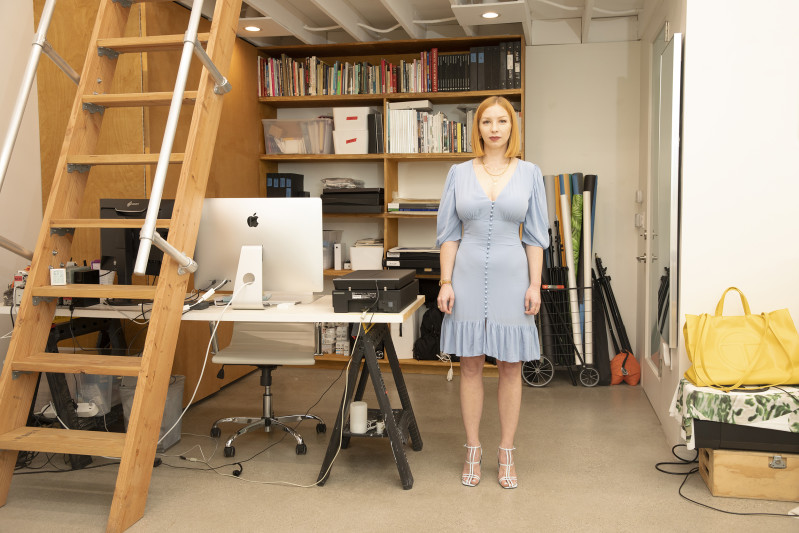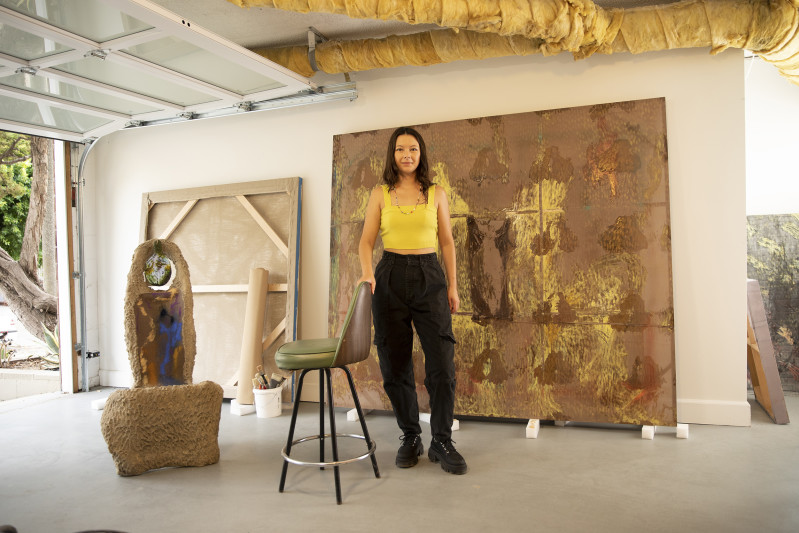Anders Krisár & Jin Meyerson in conversation with curator Cecilia Dupire
Interview
November 3, 2022

Anders Krisár, Torso 5, 2022, In steel, 47.5 x 66.5 x 21.5 cm
Written on the occasion of the joint exhibition TWO-FOLD featuring works by Jin Meyerson and Anders Krisár. Stockholm, CFHILL, November 2022.
TWO-FOLD examines the internal dialogues of two autobiographical visual accounts – primary gestures of personal negotiation that embrace and speak of the artists’ own personae. Krisár’s and Meyerson’s artworks stand as platforms for their untold stories; they are places in which the artists have lost and found themselves.
To comprehend the multifaceted complexities of these artists – the way they see, think, and act – we need to understand their origins. Both have experienced traumatic events that shaped their artistic processes and led them to create authentic, profound bodies of work.
Jin Meyerson’s paintings are dynamic: they shift constantly between visual layers. Like an atomic explosion, they inhabit a physical blast of energy that penetrates any barrier. And like fireballs of intensity, they are full of colour, lines, and light, which are blended and separated in a dialectic collision of fusion and fission, creating gateways into alternative worlds.
Anders Krisár’s sculptures are precise dissections of the body that force the beholders to complete a dialogue, filling in the absences within the works within their own minds. The works are striking combinations of classical figurative form, enhanced by acute realism and brutal amputation. Krisár explores patterns that attract and repel. To voice his urgent, intimate message, he investigates the reduction of appearance through subtraction and elimination, arriving at an underlying concept.
Both artists engage with iconographic elements that transcend a parallel existence between the ephemeral and the material world. They describe existence through distortion and supernatural truth. Technically and stylistically skilled, they constantly explore new avenues, although in vastly different ways.
Krisár and Meyerson both started out as artists more than two decades ago. They share an intense desire to express their inner melancholic longings, to connect and be seen through their works, and they have both remained committed to this central narrative, building on themes such as love, loneliness, and transient sensuousness.
Jointly drawing on an appreciation of surrealist aesthetics, they both also act on the complexities of their respective backgrounds, using conceptual metaphors to represent the human condition. Their artworks are intimate visual maps that explore, conceal, and reveal transformative representation.
Throughout their oeuvres, Meyerson and Krisár employ personal symbolism to capture fluctuating moments in singular expressions. Their works present a two-fold psychological effect, concealing one side to reveal new meaning.
The following is an unedited and unabridged transcript of an interview with Anders Krisár and Jin Meyerson by curator Cecilia Dupire.
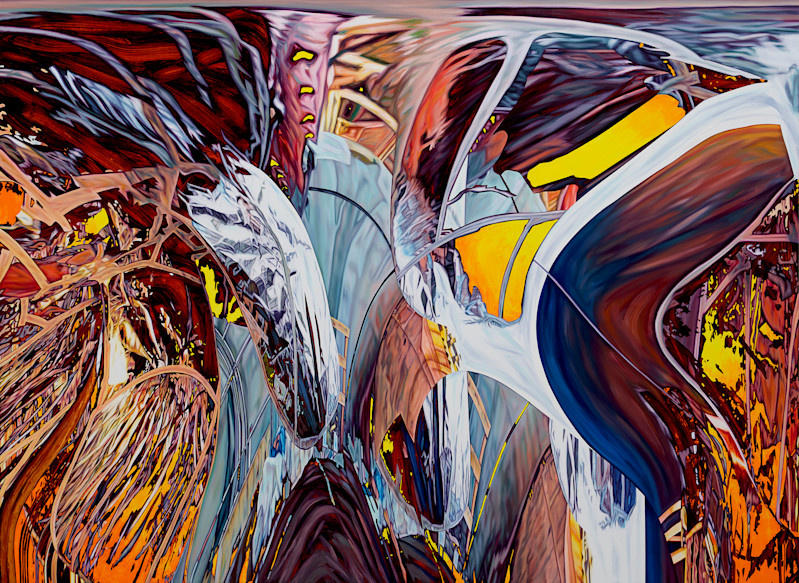
Jin Meyerson, SURVIVOR’s GUILT 2.0, 2021–22, Oil on canvas, 150 x 205 cm
Cecilia Dupire — What does it mean for you to be in Stockholm, Sweden?
Jin Meyerson — With my origin as an adopted Korean, my childhood was filled with moments with my grandmother, cousins, and other family on my adoptive mother’s side. They were all Swedish-American, so Stockholm and Sweden have been major presences in my life. Although this will only be my second trip, there is still a strong sense of reunion.
CD — How do you both feel about the upcoming exhibition?
Anders Krisár — This is the first time that I’m doing a two-person show. It hasn’t really felt right before – not until now.
JM — I have such an immense feeling of gratitude. Starting with the introduction and connection that has been provided by my profound friendship and admiration for you, Cecilia, and your family, and to you, Anders, for agreeing to participate alongside me, to Michael Elmenbeck and everyone at CFHILL for allowing me the opportunity to present my work, and to the Swedish and Scandinavian community who will make time to come and experience the exhibition. I am just completely grateful.
CD — And how do you feel about each other’s work?
JM — There is an earnest poetry to Anders’s work, something quiet and miraculous, like a gilded folk song that reaches back through the centuries to the very primal reasons that we as a species invented art. The intimacy of touch, the severity of loss – his works are delicate monuments to the things that grant us empathy and meaning beyond sheer survival.
AK — I admire Jin’s work. I was very impressed with it the first time you [Cecilia] brought it to my attention, but when I saw it live in Jin’s studio in Seoul, it blew me away. In a way, he paints what I sometimes feel but can’t visualise as directly myself. To me, it’s quite hallucinatory.
CD — What about your collaboration? How have you both prepared and decided on which works to include?

Jin Meyerson, ALLELE 9, 2022; Oil on canvas, 53 x 45.5 cm

Anders Krisár, Half Torso 3, 2020–21, Bronze (polished patina), 48.8 x 24.3 x 19.4 cm
AK — I’m excited about this show because of how Jin’s works and my own relate to each other. At first glance, they seem so different, but there is a bond between them that I can’t wait to witness in real life. I wanted to show a few new works and a few earlier works.
I’m interested to see how my earlier work will relate to Jin’s paintings. I think it might clarify the connections that exist between our two practices.
JM — I think, because our work is so remarkably linked, not so much by appearance as by the reasons of meaning that make art, that we didn’t have to adjust very much.
It’s funny, because for every project – especially one so dear and ambitious – there will always be moments where all sides are not in agreement, and I truly believe that through the differences we experienced in dealing with these disagreements, Anders and I became even closer!
Practically speaking, for me, it was such a thrill to visit Anders’s studio in Stockholm earlier this year, and to have him visit mine in Seoul. Through these exchanges, I experienced an epiphanous moment, in which I suddenly had a flash of clarity. It is something like having a good friend visit the place where you live, and finding yourself able to see something new through their presence, their eyes. This moment definitely informed the new, small figure paintings which are presented here.
CD — Jin, what was it like for you to participate in this year’s Venice Biennial, and the Armory Show in NYC?
JM — Of course, being able to be a small part of the grand history and experience of the Venice Biennial was incredibly humbling, and I was thrilled to do so. It was especially meaningful for me as I was able to join a pavilion, which was a celebration and remembrance of the May 18th uprising, hosted by the Gwangju Biennial.
I left Korea when I was around five years old, just six years before this defining moment of the Korean post-war recovery. The Gwangju uprising, in May 1980, was Korea’s Tiananmen Square moment. Pro-democracy protesters were shot in the street, and the uprising helped alter the course of Korean post-war recovery.
The Armory was also extremely meaningful, as I started my career in the late 1990s in NYC. Serendipitously, Anders and I have this origin in common, although we never met at the time. After having left NYC to live in Paris, Hong Kong, and eventually Seoul, this was the first time in fifteen years that I was able to present my work there.
CD — Anders, what was it like to participate in the first ever Seoul Frieze-KIAF fair with Johyun Gallery?
AK — I’m honoured that Johyun Gallery decided to take my work to KIAF in Seoul.
CD — Moving on to some personal questions, how did your infancies impact you?
AK — I carry a feeling of loss that can never be restored. But through art and the life I have created, I can attain a sense of solace.
JM — I’m not qualified to answer this question in terms of psychological tendencies or ideas, or theory. I know, through our conversations, about the phenomena and study of epigenetics, that environmental context can be a formative influence on our DNA, and that this is something we are all subject to. Clearly, we are all tied to the families we were born into, the food we ate, the temperatures, and the quality of the air. As I have no clear memories, and there are no records available, these things are opaque and lost from any direct knowledge.
It is, then, through this absolute loss (and the search for belonging) that this period of infancy becomes relevant. The absence of any knowledge or records is akin to having lost a primary sense receptor and still figuring out a way to know where I am, where I’m going, and how I might get there.
CD — How would you describe yourself? Who are you?
JM — I have been thinking a lot about the questions and distinctions between identity and presence. It has become a matter of critical consensus in the contemporary art world that we should embark on this great reset. Artists with marginalised and prejudiced points of heritage and identity are all being given a long-overdue opportunity to present what have previously been subverted histories and stories.
I think we all face a process of becoming. The years of our adolescence challenge us in every way imaginable, and this transition from child to adult is incredibly profound and painful. The challenge of how to navigate the complexities of contemporary existence while maintaining our core beliefs has become increasingly layered and nuanced.
I failed completely, and made every possible mistake, harming my family and my friendships, and destroying almost every caring and loving relationship that had been given to me. But it was during these years that the drawings that I had always been making transformed into paintings. The process of discovery began to gain purpose, and – most importantly – meaning.
So much of my work is about figuring out where I have come from and where I’m going, who and where I am. Still, there are times when we all let go of our need for identity, like when I get lost in the infinite details of making. Or recently, when I saw the images from the James Webb telescope for the first time.
In terms of identity, I am a son, a father, a husband, an artist of multiple points of cultural heritage, a Korean adoptee, a 50-ish male, and an active member of a global art community on which the sun never sets.
My presence, which is the work and becomes the work, relies on a fine fulcrum point, a balanced maintenance of irreconcilable loss, all-inclusive empathy, and a sense of reasonability in an era of increasingly polarised rage.
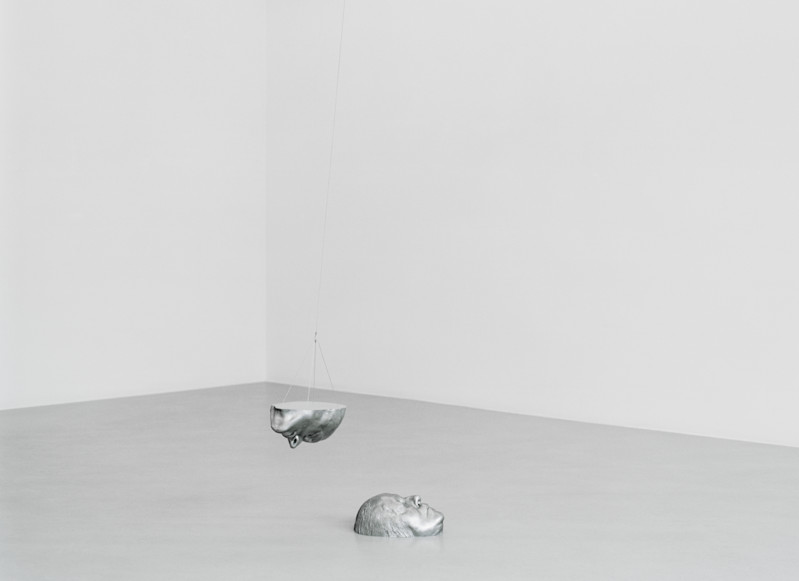
Anders Krisár, One as Two (2), 2004, Cast aluminum, magnets, lead, aluminum paint on aluminum plate, steel wire, wire lock, aluminum screws, copper pipe, plastic padding, chemical aluminum, and epoxy, two parts, 25.5 × 15 × 11 cm and 24.5 × 16 × 10 cm
AK — This is what I’m trying to figure out…
CD — To whom do you want your work to speak? Tell us about your work. What motivates you? What is it you desire to express?
AK — I make art to find relief and to better understand myself. That is my motivation, to hear myself and maybe get another piece of the puzzle. I also believe it can have the same effect on others.
JM — The greatest privilege any artist can have is an audience. We all want everyone to like or appreciate our work. Of course, this is impossible because taste is something that often defines and superimposes on quality, both in the contemporary art world and in the greater cultural world. Because meaning is essential to what I believe, I have found that my work often speaks to an audience that believes in art as a vehicle for enlightenment and renewal.
My favourite pieces of art all deal with a great sense or story of tragedy. Some of my favourite artists were never able to overcome their own loss within their lifetimes, and yet, the work they managed to produce and leave behind is this phenomenological experience of a celebration of life and adversity overcome.
In my work, I have always intended to be able to present a shared history of abandonment, of devastating loss, and, through these experiences and a process of constant discovery, an alternative space: a core place, carved out of the very centre of this great challenge.
CD — It feels like your art making has been a way for you to save yourself, to control and understand your emotions. Would you say that’s accurate?
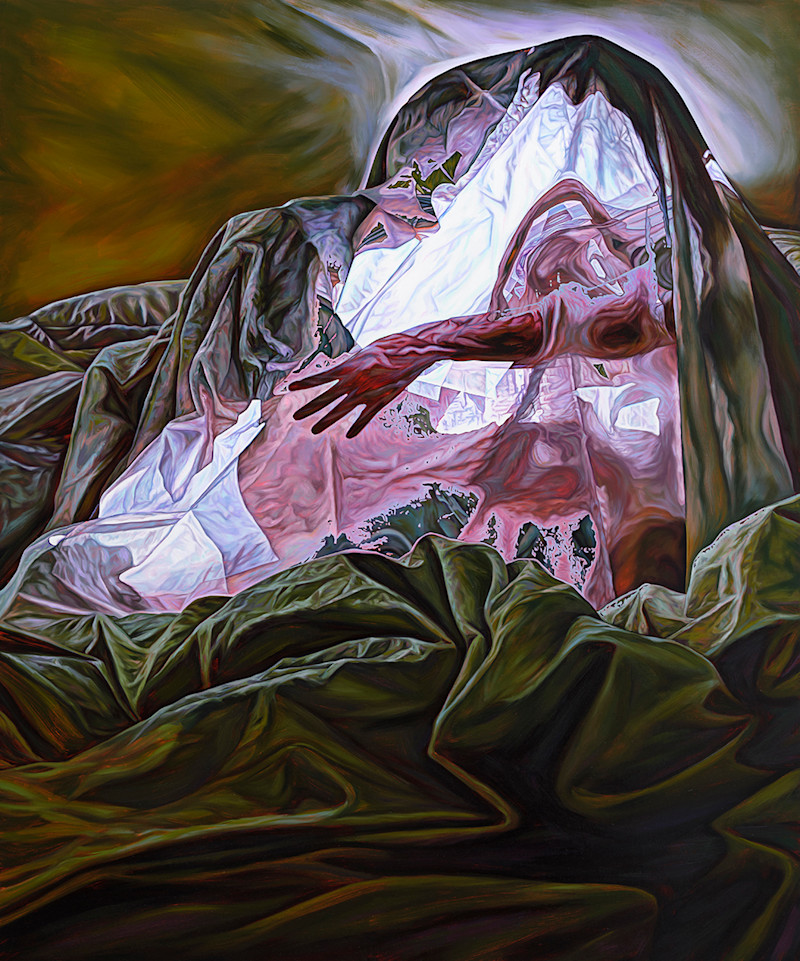
Jin Meyerson, THE UNKNOWN PRIVACIES THAT HOLD US TOGETHER, 2022, Oil on canvas 216 x 180 cm
JM — Art has always been my survival kit. I don’t know if any of us should try to control our emotions, and emotions, being primal reactions to our practical, everyday relationships to those closest to us, are generally no great mystery.
I have had to work very hard to be able to accept and harness the ebb and flow of my emotions. Knowing when it is effective and appropriate to share them. Emotions create incredibly passionate and profound moments, but as a father, son, husband, and friend, I know that they can be toxic and extremely harmful to the people we most love and deeply care about.
Of course, art is emotional in its making and shared presence, and as an artist, I often thank the stars for that. Because it is a receptacle, into which I can pour everything, I often make this joke that if not for my art, I would probably be doing hard jail time somewhere…
AK — Yes.
CD — When did you realise that painting and sculpture were the mediums for you? Where did your fascination with them come from?
AK — For me, sculpture is visually the closest thing to the physical truth. I like being able to move around a work.
JM — Drawing was the only thing that I was able to carry with me from the orphanage in Incheon. And as I have mentioned before, this was the process through which I dealt with my severed transplantation into the gravity of American culture. My Jewish-American father was a brilliant history and philosophy professor, and he made a point of taking us to every museum in every city we visited. I was introduced to art at a very early age.
Painting was something that fascinated me, and my mother told me on several occasions that security guards at museums often told her: “Your son is standing way too close to the paintings.”
I think because I lost Korean language and needed to gain English comprehension at the age that I did, and because the universal language of images and pictures – both making and receiving – were available and supported, I developed or perhaps had a special affinity for memorising detailed passages of mark making.
Of course, when we engage with any material, that material has its own presence, its own heritage and history. For me, as an outsider looking into the world of the canon of Western art history, I wanted and dreamed of being able to co-opt this grand history and make my own indelible mark as an Asian-American artist.
CD — You return to the same recurring subjects or motifs. Is this a way to rethink, redefine, and question these events, emotions, and memories?
JM — Yes, of course. We all carry these internal monuments, which come from our core beliefs and experiences. In searching for the most effective way to share these, we quickly understand that we need to try out different textures and tones of the frequencies we are expressing.
AK — I guess so. Since I work autobiographically, I think it’s natural; life itself also wanders in circles.
CD — Every material has a home and purpose. Jin, you work mostly with oil paint, and you, Anders, primarily work with metal and stone. What is it about these mediums that speaks to you, specifically?
AK — Bronze is a very convenient and beautiful metal. What first drove me to want to explore bronze was Louise Bourgeois’s magnificent hanging sculpture, Arc of Hysteria (1993). I also love how Brâncusi worked with bronze, and I remember studying his work before doing my own work in metal. Marble is such a beautiful and fragile material. I love how it is slightly transparent, just like our own skin. I also often think about how marble is made out of prehistoric sea creatures pressed together over hundreds of millions of years. So, marble relates directly to our own bodies in this way, too; it’s pretty much made out of our ancestors.

Anders Krisár, Bronze/Wax #2, 2006–08, Cast bronze, heater, bronze plate, rubber electrical cable and plug, brass screws, and metal hardware, 24.5 × 14.5 × 10.5 cm
JM — Oil painting has a cultural value tied directly to its history as one of the most challenging, slippery, sensual mediums available. It is molecular in its malleability, and because of this, mistakes and intentions require extremely specific purchase.
I think I addressed most of the other points of this question in a previous answer. I will say that it is now known that oil paint, which was often accredited to a European point of origin, was in fact created in China. Chinese ceramicists who were searching for a more durable coating for their work ground pigments into oil and covered their pieces, and soon discovered that this offered a more permanent coating solution.
CD — What I really appreciate about both of you is that your works don’t immediately reveal themselves; they always seem to have something more to say. Is this intentional?
JM — I think both Anders and I would agree that your remarkable perception uncovers layers that we ourselves were not intending or even aware of.
Of course, because my work begins with conversations, which lead to thoughts, which lead to ideas, which sometimes become sketches, and, if they stay with me and cycle back through this process, eventually become finished pieces, they are extremely layered.
As a pioneer of using “frontier optics” and early CG software for my sketching process since the late 1990s, these sketches can oftentimes reach a point of fifty to one hundred digital layers. Despite all the fine-tuning, which is done digitally, I have, on several occasions, departed completely from the painstaking preparations I’ve made.
Every decision we make and finally agree on allowing to exist, as artists, is intentional.
AK — I think this is important for a work to be successful. That the work lingers.
CD — In these bodies of work, you both have some pieces that are radically different from earlier pieces. For you, Jin, what sets it apart is that the motif is set in the natural, personal setting of your bedroom. Anders, for you, the decision of making the diver whole rather than dissected, like most of your other figurative works, seems significant. Can you tell us a bit more about these choices?
AK — High Diver (1) is something else entirely, as it is a portrait of my dad in his youth. He had a very traumatic childhood, and took refuge in high diving. In fact, he went on to become one of the best high divers in Hungary in his time. I’ve been thinking a lot about this, and I recognise the pattern. One might say that his high diving is my art making, and so it was only fitting that I combined our two practices in a single work. I have always lived with my father being schizophrenic, so this work is an investigation of my father before he became ill. In a way, the whole act of jumping off of a platform could be a metaphor for my father leaving our common reality, leaping into his own world.
JM — I have always needed a certain distance from the subject matter in my work, this is parallel and equidistant to the sense of displacement that so many of us have experienced at one time or another in our lives.
My ability to close the gap has arrived for multiple reasons; there are two primary ones. The first is the miracle of my return to Korea, my marriage to my wife and her family, and to our daughter. The second is the technological development that has become available. This has finally caught up to the ideas I have carried with me since as early as art school.
For the Seance paintings, which I have been working on for close to two years now, I engage with a LIDAR 3D-scanning program. Interestingly, the way in which I use it, focusing it on the intimacy of our darkened bedroom, save for a flashlight that is emitted from a smartphone, makes the LIDAR scan glitch as it processes the layers of sheets and then attempts to process the corresponding darkness.
These are then layered and digitally organised, manipulated, and placed, and ultimately, of course, processed through the psychology of my hands.
CD — Jin, THE UNKNOWN PRIVACIES THAT HOLD US TOGETHER and the Seance series are full of passion and angst. The paintings feel very influenced by your own experiences of exploring life, love, and your intimate fears of loneliness.
JM — Yes, and through these experiences of abandonment and loss, they are surrounded by and contain this energy, and arrive at this place of tenderness. I’m never satisfied with a singular point of arrival, or destination.
CD — Anders, the same goes for your works Untitled, 2012 and Untitled, 2013–15, with the hands of your mother. They seem to ventilate your personal fears about holding on and letting go. Can you tell us a bit more about that?

Anders Krisár, Untitled, 2013–15, Polyester resin, polyurethane, oil paint, and clothes, 23 x 39 x 38 cm
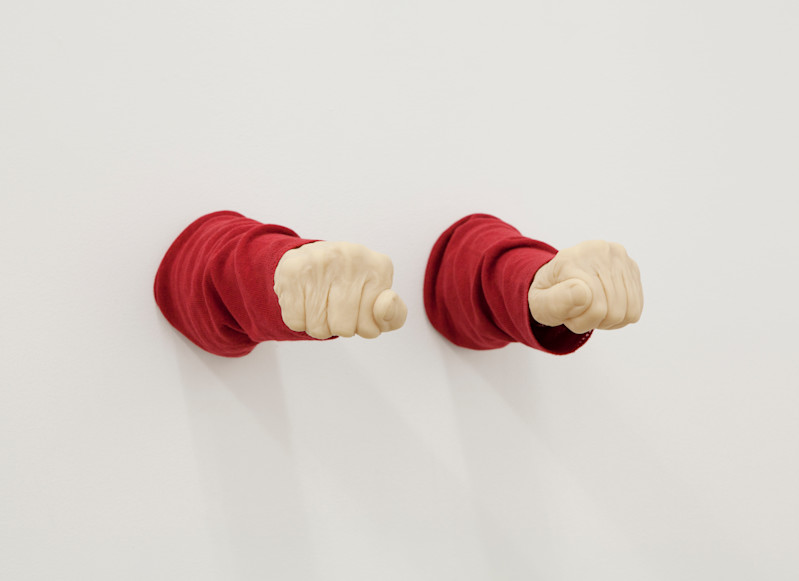
Anders Krisár, Untitled, 2012, Polyester resin, polyurethane, oil paint, and clothes, 13.5 x 35 x 35.5 cm
AK — That’s true, and these works are very personal to me. They feel almost like diary notes. I believe that’s why I haven’t shown them much in the past; Untitled, 2013–15 has, in fact, never been exhibited. In Untitled, 2012, my mother is holding one white and one black chess pawn in her hands, hiding them. This is the standard procedure when you begin a game of chess in a bar or café (I’m a tournament chess player myself). The player with the white pieces has an advantage since that player will start the game one step ahead of the other. So, I was wondering if our lives begin the same way? Was my entrance to this world random, or was it a choice? In Untitled, 2013–15, the hands are lifeless and have dropped the two pieces. They don’t have the power to affect the game anymore and the pawns (brothers?) have disappeared. I made these casts just one or two years after the first ones; I felt that my mother was getting weaker and was slowly letting go of life. She passed away a year later.
CD — How about you, Jin?
JM — One concern I have about art and therapy is that in the majority of cases one shouldn’t really consider art that is made as therapy art. Art, while therapeutic in its attention to articulating detail and its capacity for restorative recollection, is never an adequate replacement for real therapy. Art is an alternative space, which can run parallel to the space of therapy but remains distinct from it both in terms of practical purpose and practice. My art has never made me feel better about myself in a core sense – but then again, neither has therapy.
My relationships with the people I love and the sharing of conversations with them, has been my only point of salvation. Art has only allowed me to maintain survival.
CD — Looking at works like POST CALIFORNIA 3.0 and Half Girl, it’s obvious that the idea of layers plays an important role in the works both of you make. For you, Jin, it seems to be the revelation of layers, and for you, Anders, it seems to be the removal of them. Why is that so?

Jin Meyerson, POST CALIFORNIA 3.0, 2022, Oil on canvas, 220 x 161 cm
JM — This is such an astute and poignant observation; I believe I have addressed the process of layering in formal, technical terms in a previous question.
In terms of the meaning of layering, I have arrived at a point where I no longer believe in coincidence. Rather, I believe that our experiences can be perceived, and organised, to a degree, into sequences. This belief and idea is very present in the cycles of work that I have made.
As I do not work in series or editions, the interconnectedness of my work forms in cycles that accumulate overlays of thoughts, meaning, and which are all based on conversations and experiences.
AK — That is what’s so interesting about this collaboration.
Jin adds, and I subtract, yet I believe we carry a similar feeling of loss. I need total clarity in what I do, simplicity. I need to disclose everything to myself, even if it means hiding things to make it clearer.
CD — The idea of rotation seems to find expression in works by both of you. Jin, I’m thinking particularly of your AR work, which rotates around Anders’s diver. And, Anders, your face rotates around your mother’s in One as Two. What does this dynamic movement represent for you?
AK — The struggle to find love and acceptance.
JM — Everything rotates, the Earth, the sun, the universes. We are all connected to this, elementally and essentially. It’s there without our needing to think about it. I’m very specific about my rates of rotation, they are controlled by certain control mechanisms, frame rate, varying input levels, number of engines, and so on.
For the AR overlay Reunion, which rotates around Anders’s High Diver (1), I incorporated the numbers six and twenty-eight. These carry significant meaning to me, as this was the date that I left Korea as a child and the exact date that my wife was born into this world. In this case, the frame rate is 1,256, which is 628 x 2.

Anders Krisár, High Diver (1), 2022, In bronze (polished patina), 96 x 28 x 56 cm
